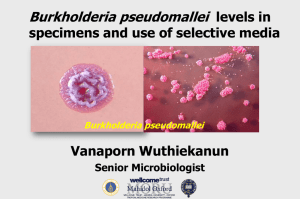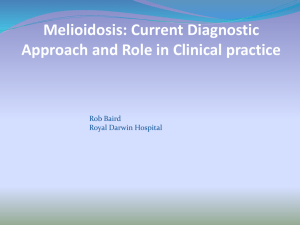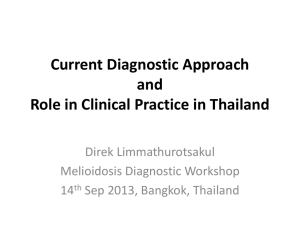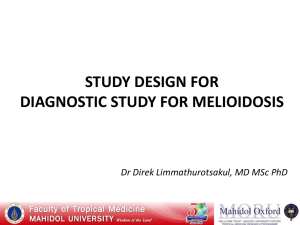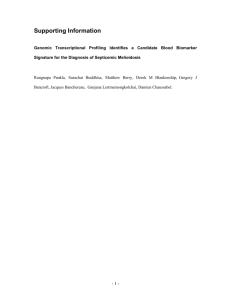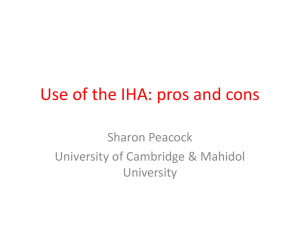Melioidosis Importance
advertisement
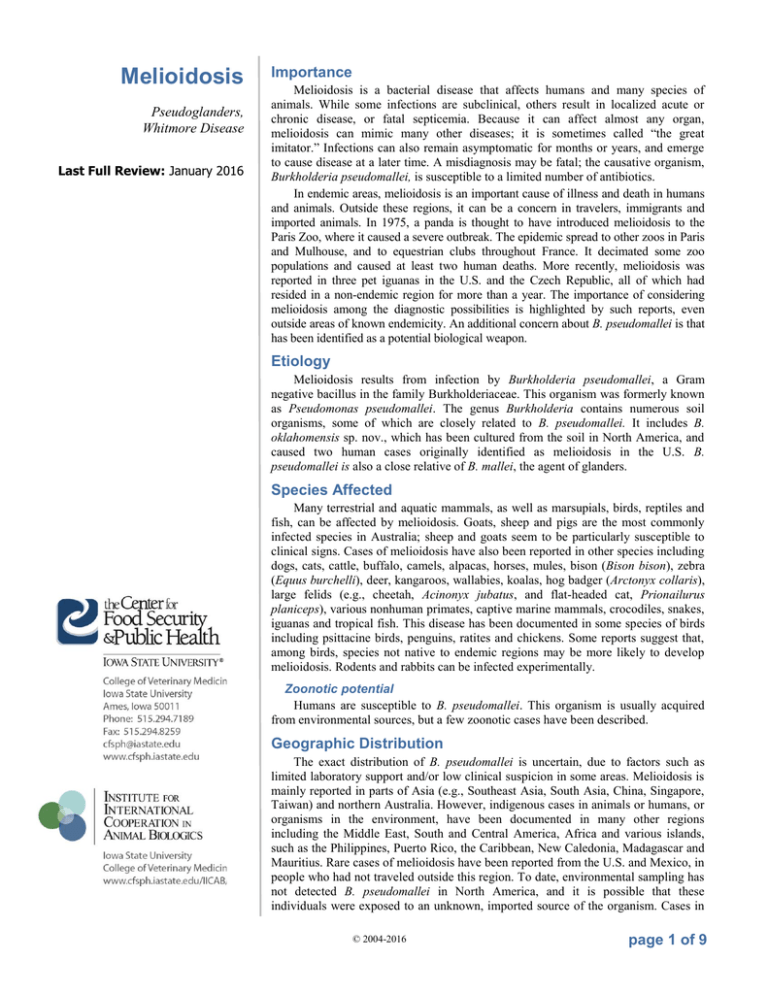
Melioidosis Pseudoglanders, Whitmore Disease Last Full Review: January 2016 Importance Melioidosis is a bacterial disease that affects humans and many species of animals. While some infections are subclinical, others result in localized acute or chronic disease, or fatal septicemia. Because it can affect almost any organ, melioidosis can mimic many other diseases; it is sometimes called “the great imitator.” Infections can also remain asymptomatic for months or years, and emerge to cause disease at a later time. A misdiagnosis may be fatal; the causative organism, Burkholderia pseudomallei, is susceptible to a limited number of antibiotics. In endemic areas, melioidosis is an important cause of illness and death in humans and animals. Outside these regions, it can be a concern in travelers, immigrants and imported animals. In 1975, a panda is thought to have introduced melioidosis to the Paris Zoo, where it caused a severe outbreak. The epidemic spread to other zoos in Paris and Mulhouse, and to equestrian clubs throughout France. It decimated some zoo populations and caused at least two human deaths. More recently, melioidosis was reported in three pet iguanas in the U.S. and the Czech Republic, all of which had resided in a non-endemic region for more than a year. The importance of considering melioidosis among the diagnostic possibilities is highlighted by such reports, even outside areas of known endemicity. An additional concern about B. pseudomallei is that has been identified as a potential biological weapon. Etiology Melioidosis results from infection by Burkholderia pseudomallei, a Gram negative bacillus in the family Burkholderiaceae. This organism was formerly known as Pseudomonas pseudomallei. The genus Burkholderia contains numerous soil organisms, some of which are closely related to B. pseudomallei. It includes B. oklahomensis sp. nov., which has been cultured from the soil in North America, and caused two human cases originally identified as melioidosis in the U.S. B. pseudomallei is also a close relative of B. mallei, the agent of glanders. Species Affected Many terrestrial and aquatic mammals, as well as marsupials, birds, reptiles and fish, can be affected by melioidosis. Goats, sheep and pigs are the most commonly infected species in Australia; sheep and goats seem to be particularly susceptible to clinical signs. Cases of melioidosis have also been reported in other species including dogs, cats, cattle, buffalo, camels, alpacas, horses, mules, bison (Bison bison), zebra (Equus burchelli), deer, kangaroos, wallabies, koalas, hog badger (Arctonyx collaris), large felids (e.g., cheetah, Acinonyx jubatus, and flat-headed cat, Prionailurus planiceps), various nonhuman primates, captive marine mammals, crocodiles, snakes, iguanas and tropical fish. This disease has been documented in some species of birds including psittacine birds, penguins, ratites and chickens. Some reports suggest that, among birds, species not native to endemic regions may be more likely to develop melioidosis. Rodents and rabbits can be infected experimentally. Zoonotic potential Humans are susceptible to B. pseudomallei. This organism is usually acquired from environmental sources, but a few zoonotic cases have been described. Geographic Distribution The exact distribution of B. pseudomallei is uncertain, due to factors such as limited laboratory support and/or low clinical suspicion in some areas. Melioidosis is mainly reported in parts of Asia (e.g., Southeast Asia, South Asia, China, Singapore, Taiwan) and northern Australia. However, indigenous cases in animals or humans, or organisms in the environment, have been documented in many other regions including the Middle East, South and Central America, Africa and various islands, such as the Philippines, Puerto Rico, the Caribbean, New Caledonia, Madagascar and Mauritius. Rare cases of melioidosis have been reported from the U.S. and Mexico, in people who had not traveled outside this region. To date, environmental sampling has not detected B. pseudomallei in North America, and it is possible that these individuals were exposed to an unknown, imported source of the organism. Cases in © 2004-2016 page 1 of 9 Melioidosis three iguanas in the U.S. and the Czech Republic were attributed to chronic infections in animals most likely imported from Latin America. Soil sampling in France detected B. pseudomallei in several locations after an outbreak in the 1970s, but whether it still exists there seems to be unclear. Transmission Animals and humans usually acquire melioidosis from organisms in the environment. B. pseudomallei is a saprophyte that occurs in soil and water in endemic areas. Its environmental niches are still incompletely understood. Although this organism is particularly common in moist soils, it can also survive for prolonged periods in intermittently irrigated soils. It is reported to be common in garden soil in some areas. There are occasional reports of its isolation from an arid location after flooding, although there was no evidence for its presence before that event. B. pseudomallei can enter the body by ingestion, via inhalation, or through wounds and abrasions. Both animals and humans can become chronically infected, with or without clinical signs. Infected animals can shed this organism in various sources such as wound exudates, nasal secretions, milk, feces and urine. Transplacental transmission has been documented in several species (goats, a pig and a spider monkey). Nosocomial transmission was reported in four cats at a veterinary hospital, possibly via contamination of a multidose injectable solution. Insects are not thought to play any significant role in transmission, although B. pseudomallei could be transmitted by mosquitoes (Aedes aegypti) and rat fleas (Xenopsylla cheopsis) in laboratory experiments. There have been a few reports of zoonotic transmission, often after skin lesions were exposed to infected animals, tissues (including meat) or milk. However, most people become infected directly from the environment. This occurs through skin wounds in many cases, but humans can also acquire B. pseudomallei via ingestion (from sources such as contaminated, unchlorinated water supplies) or inhalation. Inhalation may be particularly important during periods of heavy rainfall and strong winds, or during exposure to soil organisms from artificial turbulence (e.g., winds generated by helicopter blades). Person-to-person transmission has rarely been described, and generally occurred to family members who had been in close contact through activities such as nursing the patient. Possible sexual transmission was suggested in rare cases. Some infants seem to have been infected from human milk, and transmission may also occur in utero, although vertical transmission has rarely been proven in people. B. pseudomallei can survive for months or years in contaminated soil and water. In one report, this organism remained viable in triple distilled water at 25°C for 16 years. Other groups have reported that, under laboratory conditions, it can survive in room temperature water for as Last Updated: January 2016 long as 8 weeks, in muddy water for up to 7 months, in soil for up to 30 months, and in soil with a water content of less than 10% for up to 70 days. B pseudomallei is acid tolerant, and has been recovered from water sources ranging in pH from 2 to 9 (with good survival in the laboratory at pH ≥ 4). It was also reported to remain viable for up to a month in water containing salt concentrations as high as 0.4%, with little loss in cultivable cell numbers, and to persist for at least 4 weeks in a 4% salt solution, although the number of viable organisms decreased significantly at this concentration. How long B pseudomallei can persist at low temperatures is unclear. In two experiments, some strains survived for as long as 42 days at 0-2°C. B. pseudomallei is capable of existing in a viable but non-cultivable state in the environment. While these organisms cannot be cultured, they can still cause disease. This phenomenon occurs in acid pH, as well as under other conditions. The morphology of the viable but noncultivable organisms can change. In acid pH, for instance, they can appear as Gram-positive, coccoid organisms, which revert to conventional Gram-negative-bacilli in neutral pH. B. pseudomallei can also enter the cells of some protozoa or the mycorrhizal fungus Gigaspora decipiens, a characteristic that might help it survive environmental stresses. Disinfection B. pseudomallei is stated to be susceptible to numerous disinfectants including 1% sodium hypochlorite, 70% ethanol, glutaraldehyde and formaldehyde. However, unpublished experiments suggest that it can remain viable for some time in 0.3% chlorhexidine, and one outbreak was associated with a contaminated container of commercial hand-washing detergent. Recent experiments documented its susceptibility to a commercial peracetic acid disinfectant and Virkon®. Disinfectants may not completely eliminate this organism from drinking water, particularly when it is protected within protozoa or found in biofilms. Chlorination reduces the number of B. pseudomallei in water, but small numbers of bacteria have been isolated from water containing up to 1000 ppm. free chlorine. Strains can differ in their sensitivity to this agent. B. pseudomallei is also reported to be susceptible to inactivation by sunlight. It can be killed by moist heat of 121°C (249°F) for at least 15 min or dry heat of 160170°C (320-338°F) for at least one hour. Infections in Animals Incubation Period The incubation period ranges from days to months or years. Clinical Signs Subclinical infections are common in animals, and asymptomatic abscesses may be found at slaughter. © 2004-2016 page 2 of 9 Melioidosis Symptomatic melioidosis may be acute, subacute or chronic, and mild or severe. The lungs, spleen, liver and associated lymph nodes are often involved in animals, but any organ can be affected. The effects vary with the site. Acute melioidosis, which is most often seen in young animals, often occurs as septicemia. Localized respiratory signs, gastrointestinal signs, septic arthritis, osteomyelitis, mastitis, orchitis, neurological signs, mycotic aneurysms and other syndromes may be also seen. Septicemia or extensive involvement of the vital organs can be fatal. Forms of melioidosis reported in mammals and birds Pulmonary melioidosis is common in sheep, with clinical signs that can include fever, severe coughing, respiratory distress and profuse mucopurulent yellow nasal and ocular discharge. Some sheep become arthritic and lame. In others, the only signs may be fever and generalized weakness. Neurological signs have also been reported. Orchitis with testicular nodules can occur in rams. In goats, respiratory disease is reported to be less severe than in sheep, and coughing may not be a prominent sign. Progressive emaciation, lameness or hindleg paresis, aortic aneurysms and abortions have also been documented in this species. Mastitis appears to be a common syndrome in goats. Pigs may be relatively resistant to melioidosis when husbandry and nutrition are good. Adult pigs tend to develop chronic infections with few clinical signs; however, enlarged lymph nodes (particularly the submandibular nodes) may be palpable. Progressive emaciation, neurological signs, incoordination, multiple skin ulcers and diarrhea have also been reported. Young pigs can develop acute septicemia with fever, anorexia, coughing and nasal and ocular discharge. Occasional abortions or stillbirths have been seen in sows, and orchitis can occur in boars. In endemic regions, asymptomatic splenic abscesses are often found in pigs at slaughter. Various forms of melioidosis have been reported in horses. Generally, the disease lasts approximately a few weeks to a few months, with clinical signs that may include weakness, emaciation, edema and lymphangitis of the limbs, mild colic, diarrhea, and signs of pneumonia including coughing and nasal discharge. Skin infections can initially resemble fungal eczema, but later become papular. Hyperacute septicemia with high fever, limb edema, diarrhea and rapid death has also been seen. Acute meningoencephalitis has been reported in rare cases. Melioidosis has rarely been described in cattle. Most cases in adult cattle have been chronic. Fever, dyspnea, continuous profuse salivation and neurologic signs were reported in one animal. In two other cases, abscessation or acute, localized arthritis occurred after wound contamination. Acute melioidosis was reported in a calf. Camels may develop chronic respiratory disease with a hacking cough, purulent nasal discharge and dyspnea. Other Last Updated: January 2016 animals had hindleg ataxia and a wasting disease with severe emaciation. Acute septicemia has been seen in both camels and alpacas. Acute, subacute or chronic melioidosis can occur in dogs. Acute cases in this species are often characterized by septicemia. Signs may include fever, severe diarrhea and fulminant pneumonia. Subacute disease can begin as a skin lesion with lymphangitis and lymphadenitis; untreated cases may progress to septicemia over a week to several months. Respiratory disease can also be the initial syndrome. In addition, chronic disease can occur in any organ; it may be accompanied by anorexia, myalgia, edema of the limbs and skin abscesses. Abscesses have also been reported in various organs in cats. In two published cases, the clinical signs were not strongly suggestive of an infectious disease. One cat presented with jaundice and anemia, and died soon after it was seen. Fatal neurological disease was reported in the second cat, possibly after dissemination from an infected foot wound. Nonspecific signs of illness, fever, generalized lymphadenopathy and respiratory signs were common in affected zoo mammals and marsupials in Thailand. Most cases in captive marine mammals have been characterized by acute septicemia with fever, inappetence, anorexia and listlessness followed by death. Unlike other species, respiratory distress was not reported. Enteric disease with diarrhea and liver abscesses has been seen in some dolphins. Three cases in iguanas were characterized by masses in internal organs and/or external abscesses. Some animals had recurrent or repeated abscess formation. Although birds may be relatively resistant to melioidosis, fatal cases with lethargy, anorexia and diarrhea have been reported in various avian species in Australia. Experimentally infected chickens remained asymptomatic; however, facial abscesses were reported in a naturally infected chicken. Post Mortem Lesions Click to view images At necropsy, the major findings are multiple abscesses containing thick, caseous greenish-yellow or off-white material. These abscesses are generally not calcified. The regional lymph nodes, lungs, spleen, liver and subcutaneous tissues are most often involved, but abscesses can occur in most organs. Splenic abscesses are reported to be common in asymptomatic pigs at slaughter. In animals with respiratory disease, exudative bronchopneumonia, consolidation and/or abscesses may be found in the lungs. Suppurative lesions including nodules and ulcers may also be detected on the nasal mucosa and septum, as well as on the turbinate bones. These nodules may coalesce to form irregular plaques. Meningoencephalitis, severe enteritis, suppurative polyarthritis, mycotic aneurisms, mastitis and other syndromes have also been documented in animals. Diffuse pinpoint nodules in the liver and spleen are reported to be common lesions in birds. © 2004-2016 page 3 of 9 Melioidosis Diagnostic Tests Treatment Culturing B. pseudomallei is currently considered to be the gold standard test for melioidosis in both animals and people. This organism may be found in various sites including abscesses and wound exudates, milk, feces, throat swabs, blood, urine, and tissues collected at necropsy. It will grow on most media including blood agar. Selective media such as Ashdown's medium are often used in endemic regions. Ashdown’s medium selects for gentamicin resistance, a characteristic of most B. pseudomallei; however, gentamicin-susceptible strains were recently reported to be common in some areas. Colonies of B. pseudomallei can be identified by biochemistry combined with microscopic and culture appearance. On microscopic examination, the organisms are classically described as motile, short Gram negative bacilli, with bipolar or irregular staining. However, their form can differ from this description, for instance in older cultures or clinical samples. PCR and antigen detection tests (e.g., latex agglutination, immunofluorescence) are also used for identification. There have been multiple reports of the misidentification of B. pseudomallei by automated identification systems, although some sources indicate that these systems can identify most isolates. It is also possible to mistake this organism for Pseudomonas or a contaminant during manual culture and identification. Misidentification is a particular concern in non-endemic areas, where the isolation of B. pseudomallei is unexpected. B. pseudomallei is a biosafety level 3 organism, and not all laboratories are equipped to safely culture and identify this organism. Other tests that can be used to identify B. pseudomallei in clinical samples include antigen detection assays such as direct immunofluorescence, latex agglutination or ELISAs, and PCR tests to detect nucleic acids. The specific tests available can differ between regions, and PCR does not appear to be widely used at present. Genetic techniques that may be used for epidemiological purposes include PCR– restriction fragment length polymorphism, pulse-field gel electrophoresis, 16S rRNA sequencing, variable number tandem repeat polymorphism and multilocus sequence typing (MLST). These tests may be available mainly in research laboratories. Serology is sometimes used to diagnose melioidosis in animals, but it is not considered to be definitive. Animals in endemic areas often have pre-existing titers to this organism, and there may be cross-reactions with closely related species such as B. mallei or B, cepecia. False positives have also been reported from other Gram negative bacteria including Legionella spp. Some of the available serological tests include indirect hemagglutination, immunofluorescence and complement fixation. Environmental samples are sometimes taken from soil and/ or water during outbreaks or case investigations. Recommended methods and sampling protocols for surveillance have been published. B. pseudomallei is susceptible to some antibiotics; however, this organism is intrinsically resistant to many drugs, including some that are commonly used to treat bacterial infections. Because relapses can occur when treatment is stopped, animals given antibiotics may need to be monitored afterward. Treatment regimens similar to those currently used in humans, with intravenous therapy followed by an eradication stage, may be effective in animals; however, there are no published reports evaluating their use. Because treatment can be expensive and protracted, and it may not eliminate the organism, some animals are euthanized instead. Treatment of infected animals may not be allowed in some areas. Last Updated: January 2016 Control Disease reporting Veterinarians who suspect melioidosis should follow their national and/or local guidelines for disease reporting. In the U.S., this disease is reportable in animals in some states. State or federal authorities should be consulted for specific regulations and information. Prevention Melioidosis is usually acquired from the environment, particularly after contact with soil or water. To minimize contact with dirt, animals can be raised on wooden slats, concrete or paved floors. Providing safe drinking water (e.g., by filtration and chlorination) is also important in endemic areas. Carnivores and omnivores should not be allowed to eat contaminated carcasses. Licensed vaccines are not available. Euthanasia of infected animals is often recommended even in endemic areas, because melioidosis is difficult to treat and can be zoonotic. After culling infected animals, the premises should be disinfected. Disinfecting some environments may be difficult. The soil in one exhibit at a Thai zoo was decontaminated by mixing in quicklime (calcium oxide) and left for approximately one year, after which time repeat cultures found no evidence of B. pseudomallei. If infected animals are not euthanized, precautions should be taken to protect people and other animals. Strict hygiene is necessary to prevent transmission from infected horses in stables. The feces should be removed several times a day, and the premises, and the hooves and lower legs of the animals should be disinfected regularly. Food and water should be provided as aseptically as possible. Standing water should be allowed only in limited quantities or disinfected immediately. Morbidity and Mortality Susceptibility to melioidosis may differ between species and individual animals. Immunosuppression may predispose cats and dogs to this disease. Pigs generally seem to be more resistant to clinical signs than sheep and © 2004-2016 page 4 of 9 Melioidosis goats, and infections in cattle are very rarely reported. One report indicated that, among zoo animals, orangutans (Pongo pygmaeus) appeared to be unusually susceptible, with cases usually developing into septicemia and ending in death within a week. Although melioidosis does not appear to be a problem in marine mammals in the wild, an outbreak occurred in marine mammals at a Hong Kong oceanarium after heavy summer rains washed soil into the animals’ water. The mortality rate varies with the site of the lesions, but can be high in sheep. Extensive abscesses and involvement of the vital organs can be fatal. Septicemia has a high case fatality rate, but it seems to be less common in animals than humans. Most cases of septicemia are seen in young animals. Infections in Humans Incubation Period The incubation period in humans varies from less than a day (after very high exposure) to several months or years. In one study, most acute cases became apparent within 21 days after exposure, with a mean of 9 days. A few cases have remained subclinical for up to 29 years, and one infection apparently became symptomatic after 62 years. Clinical Signs B. pseudomallei can cause a wide spectrum of clinical signs in people. While many infections seem to be inapparent, some result in acute pulmonary disease, septicemia, or localized acute or chronic suppurative infections. The frequency of the various syndromes can differ between regions. For example, parotid abscesses are common among children in Thailand, but rare in Australia. One syndrome can develop into another if the organisms spread to other sites. Acute localized infections sometimes occur at the site of inoculation. In Australia, localized skin disease was reported to be a common form of melioidosis in children. Lesions in the skin typically appear as gray or white, firm nodules and ulcers, which are often but not always single. The nodules may caseate, and are often surrounded by inflammation. They may be accompanied by regional lymphadenopathy and lymphangitis. Other forms of acute localized disease include suppurative parotitis/ parotid abscesses, destructive corneal ulcers seen after corneal trauma, and cellulitis or infections that resemble necrotizing fasciitis. Genitourinary infections often manifest as prostatic abscesses. Localized infections can disseminate, but systemic infections are not always preceded by localized signs. Skin and subcutaneous infections can also result from the hematogenous spread of organisms from other sites. Pulmonary disease is a common syndrome in people. It can occur as either the primary syndrome or a component of septicemia, and may develop either suddenly or gradually Last Updated: January 2016 after a nonspecific prodromal illness. Pulmonary melioidosis ranges in severity from mild acute or subacute pneumonia to respiratory distress with overwhelming septic shock. Common symptoms include fever, coughing, pleuritic chest pain and, in some cases, hemoptysis. However, patients with pneumonia as a component of septicemia often have little coughing or pleuritic pain, although they are febrile and severely ill. Chronic pulmonary melioidosis can wax and wane and resembles tuberculosis, with weight loss, fevers, night sweats, and a productive cough, sometimes with blood-tinged sputum. Ulcerative lesions and nodules are sometimes found in the nose, and the septum may perforate. Complications may include pneumothorax, empyema and pericarditis. Untreated cases can progress to septicemia. Septicemia is the most serious form of melioidosis. It is most common in people with pre-existing diseases such as diabetes, cancer and kidney failure. The onset is usually acute, with fever, rigors and other typical signs of sepsis. However, it may develop more gradually in some patients, with a fluctuating fever often associated with severe weight loss. Common symptoms of septicemic melioidosis include fever, severe headache, disorientation, pharyngitis, upper abdominal pain, diarrhea, jaundice and notable muscle tenderness. Pulmonary signs including dyspnea are common, and arthritis or meningitis may be seen. Some patients have a disseminated pustular rash with regional lymphadenopathy, cellulitis or lymphangitis. Septic shock is common and life-threatening. In chronic cases, abscesses and suppurative lesions can occur in a variety of organs. Although the liver, spleen, skeletal muscle and prostate gland are often affected, lesions may be found in a variety of other organs including the skin, lung, kidney, myocardium, bone, joints, lymph nodes and testes. Mycotic aneurysms are also seen. Uncommonly, melioidosis can result in brain abscesses, encephalomyelitis (with various syndromes including flaccid paralysis) or meningitis. There may be severe residual defects in cases of encephalitis. Diagnostic Tests Isolation of B. pseudomallei in culture is considered to be the gold standard test for melioidosis in people, as it is in animals, and the techniques are the same. In human clinical cases, B. pseudomallei can be recovered from sources such as blood, sputum, throat or rectal swabs, urine, skin lesions or ulcer swabs, tissues and wound exudates. Sampling multiple sites, rather than limiting samples to the apparent focus of the infection, is more likely to detect the organism. B. pseudomallei can sometimes be found in samples such as urine even if there are no signs associated with the urinary tract. Culture is not successful in all cases of melioidosis. B. pseudomallei antigens may be identified directly in tissues, wound exudates or body fluids by assays such as direct immunofluorescence or latex agglutination, particularly if the number of bacteria is high. Lateral flow © 2004-2016 page 5 of 9 Melioidosis immunoassays have also been developed. PCR is reported to be no more sensitive than culture for detecting melioidosis in humans, and does not seem to be widely used at present. Matrix-assisted laser desorption ionization time-of-flight mass spectrometry (MALDI-TOF MS) methods are being investigated. As in animals, specialized genetic techniques can be used in epidemiological studies. Serological tests may be helpful in some circumstances, particularly when paired sera are available. In some cases, a high single titer in the presence of clinical signs may be suggestive. However, most of the population is seropositive in some (but not all) endemic areas, limiting the value of these assays. A number of serological tests have been described in humans, including agglutination, indirect hemagglutination, immunofluorescence, ELISAs, and immunochromatographic tests (ICT). Test availability differs between regions, but indirect hemagglutination is a commonly used test. People with symptomatic melioidosis are occasionally seronegative, and cross-reactivity with other organisms is possible. Treatment Although a few cases with only localized skin lesions were reported to heal spontaneously, melioidosis is treated even when it is localized or mild, due to the risk that the organism may persist and/or disseminate. B. pseudomallei is not susceptible to some drugs that are often used empirically to treat infections. Combinations of drugs were generally used for treatment in the past, but some newer single antibiotics are equally effective. At present, the recommended protocol is a two-stage therapy. Initially, patients receive intravenous antibiotics for a minimum of 10-14 days (longer in some conditions). This is followed by prolonged antibiotic treatment, usually with oral drugs, for several months or longer. The purpose of the second stage is to eliminate the organisms from the body. Prolonged oral treatment alone was reported to be effective in some milder conditions in healthy people. Some patients also require adjunct treatments, such as supportive therapy for septic shock. Pulmonary resection or drainage of abscesses is occasionally necessary. At one time, up to 30% of patients relapsed after being treated for melioidosis. However relapses are much less common with newer treatment regimens, and tend to occur mainly in cases where the course of antibiotics is not completed. Control B. pseudomallei is widely distributed in soil and standing water in endemic regions. Skin wounds (including abrasions or burns) should be protected from potential contamination, and promptly and thoroughly cleansed if they become exposed. Gloves and rubber boots are recommended for anyone doing agricultural work. Because B. pseudomallei can be found in milk from infected ruminants, only pasteurized dairy products should be Last Updated: January 2016 consumed. Chlorination of the water supply decreases the risk of infection from this source, and carcasses with signs of melioidosis are condemned and not used for human food. .People who process meat should wear gloves and disinfect their knives regularly. Veterinarians should also take precautions to avoid exposure, including the use of gloves and protective clothing, when working with infected animals or collecting diagnostic samples. People with diabetes or other predisposing conditions should be especially vigilant in avoiding exposure, including potential inhalation during severe weather events. Screening for melioidosis has been recommended for patients who will be starting immunosuppressive therapy in an endemic area. Laboratory workers may be exposed in clinical samples from patients, even where melioidosis is not endemic. Practices such as sniffing opened culture plates should be discouraged. Postexposure prophylaxis may sometimes be given after laboratory exposure, but its effectiveness is currently uncertain. In hospitals, ordinary precautions to prevent transmission in blood and body fluids should be taken. No vaccine is currently available for humans. Morbidity and Mortality Melioidosis can occur as sporadic cases or outbreaks in endemic regions. The number of cases typically increases after heavy rainfall or flooding. While this disease is most common in tropical and subtropical areas, it has been reported in arid regions after floods. Some outbreaks have been linked to contaminated drinking water supplies, and occasionally to unusual sources, such as a container of contaminated hand washing detergent. Occasional cases occur outside endemic areas in immigrants and travelers. Most human illnesses seem to appear soon after exposure; however, B. pseudomallei can persist asymptomatically in the body and cause disease at a later time, typically when another condition causes the person to become debilitated or immunosuppressed. One study in Australia suggested than <4% of recognized cases potentially result from the reactivation of latent lesions. The incidence of melioidosis is reported to peak between the ages of 40 and 60 among adults in Thailand. This disease is particularly common in people with diabetes. Other chronic conditions including thalassemia, kidney disease, chronic lung disease, cancer and alcoholism, as well as the use of immunosuppressive drugs (e.g., steroids), also increase the risk of illness. However, some cases occur in previously healthy people. Children account for 5-15% of melioidosis cases in Australia, and do not have any risk factors in most cases. Seroprevalence rates vary widely in endemic regions: while > 50% of the population may be seropositive in parts of Thailand, one study reported that antibodies to B. pseudomallei occurred in <10% of people at high risk of exposure in Australia. It is currently unclear how many seropositive people without clinical signs might be carrying this organism. Colonization © 2004-2016 page 6 of 9 Melioidosis without disease is currently considered unlikely, although there are reports suggesting that it might occur. The severity of melioidosis is influenced by factors such as the host’s immunity, the form of the disease, and the dose and possibly the strain of the organism. For example, acute suppurative parotiditis or localized skin disease in children usually has a good prognosis. Conversely, septic shock is rapidly fatal without treatment, and has a high risk of death even with good care. Case fatality rates for melioidosis have decreased in recent years in some areas, most likely due to improved recognition and treatment. Recent estimates of the overall mortality rate for all patients range from approximately 10% in Australia to 40% in Thailand, and can be higher in other areas where only limited medical care is available. Australia reports that deaths are currently uncommon in patients without known risk factors for melioidosis, provided there is prompt recognition of the condition, treatment with appropriate antibiotics, and state-of-the-art management of sepsis. In one large prospective study from Australia, the case fatality rate ranged from 4% in patients without septic shock to 50% in patients with septic shock. Cases in infants can also be severe. One review reported a case fatality rate of 73% in published cases of neonatal melioidosis.. Internet Resources Centers for Disease Control and Prevention (CDC) http://www.cdc.gov/melioidosis/index.html eMedicine. Glanders and Melioidosis http://emedicine.medscape.com/article/830235overview Public Health Agency of Canada. Pathogen Safety Data Sheets http://www.phac-aspc.gc.ca/lab-bio/res/psds-ftss/indexeng.php The Merck Manual http://www.merckmanuals.com/professional The Merck Veterinary Manual http://www.merckvetmanual.com/mvm/index.html References Alexander AD, Binn LN, Elisberg B, Husted P, Huxsoll DL, Marshall JD Jr, Needy CF, White AD. Zoonotic infections in military scout and tracker dogs in Vietnam. Infect Immun. 1972;5:745-9. Animal Health Australia. The National Animal Health Information System [NAHIS]. Melioidosis [online]. NAHIS; 2001 Oct. Available at: http://www.brs.gov.au/usr–bin/aphb/ ahsq?dislist=alpha.* Accessed 4 Oct 2002. Baker AL, Ezzahir J, Gardiner C, Shipton W, Warner JM. Environmental attributes influencing the distribution of Burkholderia pseudomallei in Northern Australia. PLoS One. 2015;10(9):e0138953. Last Updated: January 2016 Bauernfeind A, Roller C, Meyer D, Jungwirth R, Schneider I. Molecular procedure for rapid detection of Burkholderia mallei and Burkholderia pseudomallei. J Clin Microbiol. 1998; 36: 2737-41. Benoit TJ, Blaney DD, Doker TJ, Gee JE, Elrod MG, Rolim DB, Inglis TJ, Hoffmaster AR, Bower WA, Walke HT. A review of melioidosis cases in the Americas. Am J Trop Med Hyg. 2015;93(6):1134-9. Birnie E, Wiersinga WJ, Limmathurotsakul D, Grobusch MP. Melioidosis in Africa: should we be looking more closely? Future Microbiol. 2015;10(2):273-81. Brilhante RS, Bandeira TJ, Cordeiro RA, Grangeiro TB, Lima RA, Ribeiro JF, Castelo-Branco DS, Rodrigues JL, Coelho IC, Magalhães FG, Rocha MF, Sidrim JJ. Clinicalepidemiological features of 13 cases of melioidosis in Brazil. J Clin Microbiol. 2012;50(10):3349-52. Centers for Disease Control and Prevention (CDC). Laboratory exposure to Burkholderia pseudomallei--Los Angeles, California, 2003. MMWR Morb Mortal Wkly Rep. 2004;53:988-90. Chen PS, Chen YS, Lin HH, Liu PJ, Ni WF, Hsueh PT, Liang SH, Chen C, Chen YL. Airborne transmission of melioidosis to humans from environmental aerosols contaminated with B. pseudomallei. PLoS Negl Trop Dis. 2015;9(6):e0003834. Cheng AC, Currie BJ. Melioidosis: epidemiology, pathophysiology, and management. Clin Microbiol Rev. 2005;18:383-416. Cheng JW, Hayden MK, Singh K, Heimler I, Gee JE, Proia L, Sha BE. Burkholderia pseudomallei infection in US traveler returning from Mexico, 2014. Emerg Infect Dis. 2015;21(10):1884-5. Choy JL. Melioidosis. In: Kahn CM, Line S, Aiello SE, editors. The Merck veterinary manual. Whitehouse Station, NJ: Merck and Co; 2015. Available at: http://www.merckvetmanual.com/mvm/generalized_conditions/m elioidosis/overview_of_melioidosis.html. Accessed 13 Jan 2016. Choy JL, Mayo M, Janmaat A, Currie BJ. Animal melioidosis in Australia. Acta Trop. 2000;74:153-8. Currie BJ. Melioidosis: evolving concepts in epidemiology, pathogenesis, and treatment. Semin Respir Crit Care Med. 2015;36(1):111-25. Currie BJ, Ward L, Cheng AC. The epidemiology and clinical spectrum of melioidosis: 540 cases from the 20 year Darwin prospective study. PLoS Negl Trop Dis. 2010;4(11):e900. Dance DA. Melioidosis as an emerging global problem. Acta Trop. 2000;74:115-9. Dance D. Treatment and prophylaxis of melioidosis. Int J Antimicrob Agents. 2014;43(4):310-8. Doker TJ, Quinn CL, Salehi ED, Sherwood JJ, Benoit TJ, Glass Elrod M, Gee JE, Shadomy SV, Bower WA, Hoffmaster AR, Walke HT, Blaney DD, DiOrio MS; Melioidosis Investigation Team. Fatal Burkholderia pseudomallei infection initially reported as a Bacillus species, Ohio, 2013. Am J Trop Med Hyg. 2014;91(4):743-6. Doker TJ, Sharp TM, Rivera-Garcia B, Perez-Padilla J, Benoit TJ, et al. Contact investigation of melioidosis cases reveals regional endemicity in Puerto Rico.Clin Infect Dis. 2015;60(2):243-50. © 2004-2016 page 7 of 9 Melioidosis Elschner MC, Hnizdo J, Stamm I, El-Adawy H, Mertens K, Melzer F. Isolation of the highly pathogenic and zoonotic agent Burkholderia pseudomallei from a pet green iguana in Prague, Czech Republic. BMC Vet Res. 2014;10:283. Engelthaler DM, Bowers J, Schupp JA, Pearson T, Ginther J et al. Molecular investigations of a locally acquired case of melioidosis in southern AZ, USA. PLoS Negl Trop Dis. 2011;5(10):e1347. Foong YC, Tan M, Bradbury RS. Melioidosis: a review. Rural Remote Health. 2014;14(4):2763. Garner G, Saville P, Fediaevsky A. Manual for the recognition of exotic diseases of livestock: A reference guide for animal health staff [online]. Food and Agriculture Organization of the United Nations [FAO]; 2003. Melioidodis. Available at: http://www.spc.int/rahs/.* Accessed 19 Nov 2007. Glass MB, Steigerwalt AG, Jordan JG, Wilkins PP, Gee JE. Burkholderia oklahomensis sp. nov., a Burkholderia pseudomallei-like species formerly known as the Oklahoma strain of Pseudomonas pseudomallei. Int J Syst Evol Microbiol. 2006;56:2171-6. Hall CM, Busch JD, Shippy K, Allender CJ, Kaestli M, Mayo M, Sahl JW, Schupp JM, Colman RE, Keim P, Currie BJ, Wagner DM. Diverse Burkholderia species isolated from soils in the southern United States with no evidence of B. pseudomallei. PLoS One. 2015;10(11):e0143254. Hampton V, Kaestli M, Mayo M, Choy JL, Harrington G, Richardson L, Benedict S, Noske R, Garnett ST, Godoy D, Spratt BG, Currie BJ. Melioidosis in birds and Burkholderia pseudomallei dispersal, Australia. Emerg Infect Dis. 2011;17(7):1310-2. Hoffmaster AR, AuCoin D, Baccam P, Baggett HC, Baird R et al. Melioidosis diagnostic workshop, 2013. Emerg Infect Dis. 2015;21(2). doi: 10.3201/eid2102.141045. Howard K, Inglis TJ. Disinfection of Burkholderia pseudomallei in potable water. Water Res. 2005;39:1085-92. Herenda D, Chambers PG, Ettriqui A, Seneviratna P, da Silva TJP. Manual on meat inspection for developing countries [online]. FAO animal production and health paper 119. Publishing and Multimedia Service, Information Division, FAO; 1994 (reprinted 2000). Melioidosis. Available at: http://www.fao.org/docrep/003/t0756e/t0756e00.htm. Accessed 27 Aug 2007. Inglis TJ, Merritt A, Chidlow G, Aravena-Roman M, Harnett G. Comparison of diagnostic laboratory methods for identification of Burkholderia pseudomallei. Clin Microbiol. 2005;43:2201-6. Inglis TJ, Sagripanti JL Environmental factors that affect the survival and persistence of Burkholderia pseudomallei. Appl Environ Microbiol. 2006;72:6865-75. Jabbar Z, Currie BJ. Melioidosis and the kidney. Nephrology (Carlton). 2013;18(3):169-75. James GL, Delaney B, Ward L, Freeman K, Mayo M, Currie BJ. Surprisingly low seroprevalence of Burkholderia pseudomallei in exposed healthy adults in the Darwin region of tropical Australia where melioidosis is highly endemic. Clin Vaccine Immunol. 2013;20(5):759-60. Last Updated: January 2016 Kaestli M, Harrington G, Mayo M, Chatfield MD, Harrington I, Hill A, Munksgaard N, Gibb K, Currie BJ. What drives the occurrence of the melioidosis bacterium Burkholderia pseudomallei in domestic gardens? PLoS Negl Trop Dis. 2015;9(3):e0003635. Kasantikul T, Sommanustweechai A, Polsrila K, Kongkham W, Chaisongkram C, Sanannu S, Kongmakee P, Narongwanichgarn W, Bush M, Sermswan RW, Banlunara W. Retrospective study on fatal melioidosis in captive zoo animals in Thailand. Transbound Emerg Dis. 2015 Jan 13. [Epub ahead of print]. Kortepeter M, Christopher G, Cieslak T, Culpepper R, Darling R, Pavlin J, Rowe J, McKee K, Eitzen E, editors. Medical management of biological casualties handbook [online]. 4th ed. United States Department of Defense; 2001. Glanders and melioidosis. Available at: http://www.vnh.org/ BIOCASU/8.html.* Accessed 26 Oct 2002. Larsen E, Smith JJ, Norton R, Corkeron M. Survival, sublethal injury, and recovery of environmental Burkholderia pseudomallei in soil subjected to desiccation. Appl Environ Microbiol. 2013;79(7):2424-7. Lau SK, Sridhar S, Ho CC, Chow WN, Lee KC, Lam CW, Yuen KY, Woo PC. Laboratory diagnosis of melioidosis: past, present and future. Exp Biol Med (Maywood). 2015;240(6):742-51. Limmathurotsakul D, Dance DA, Wuthiekanun V, Kaestli M, Mayo M et al. Systematic review and consensus guidelines for environmental sampling of Burkholderia pseudomallei. PLoS Negl Trop Dis. 2013;7(3):e2105. Limmathurotsakul D, Peacock SJ. Melioidosis: a clinical overview. Br Med Bull. 2011;99:125-39. Limmathurotsakul D, Thammasart S, Warrasuth N, Thapanagulsak P, Jatapai A, Pengreungrojanachai V, Anun S, Joraka W, Thongkamkoon P, Saiyen P, Wongratanacheewin S, Day NP, Peacock SJ. Melioidosis in animals, Thailand, 2006-2010.Emerg Infect Dis. 2012;18(2):325-7. Limmathurotsakul D, Wongsuvan G, Aanensen D, Ngamwilai S, Saiprom N, Rongkard P, Thaipadungpanit J, Kanoksil M, Chantratita N, Day NP, Peacock SJ. Melioidosis caused by Burkholderia pseudomallei in drinking water, Thailand, 2012. Emerg Infect Dis. 2014;20(2):265-8. Lipsitz R, Garges S, Aurigemma R, Baccam P, Blaney DD et al. Workshop on treatment of and postexposure prophylaxis for Burkholderia pseudomallei and B. mallei infection, 2010. Emerg Infect Dis. 2012;18(12):e2. Loveleena , Chaudhry R, Dhawan B. Melioidosis; the remarkable imitator: recent perspectives. J Assoc Physicians India. 2004;52:417-20. Maharjan B, Chantratita N, Vesaratchavest M, Cheng A, Wuthiekanun V, Chierakul W, Chaowagul W, Day NP, Peacock SJ. Recurrent melioidosis in patients in northeast Thailand is frequently due to reinfection rather than relapse. J Clin Microbiol. 2005;43:6032-4. McLeod C, Morris PS, Bauert PA, Kilburn CJ, Ward LM, Baird RW, Currie BJ. Clinical presentation and medical management of melioidosis in children: a 24-year prospective study in the Northern Territory of Australia and review of the literature. Clin Infect Dis. 2015;60(1):21-6. © 2004-2016 page 8 of 9 Melioidosis Millan JM, Mayo M, Gal D, Janmaat A, Currie BJ. Clinical variation in melioidosis in pigs with clonal infection following possible environmental contamination from bore water. Vet J. 2007;174:200-2. Monastyrskaya G, Fushan A, Abaev I, Kostina M, Filyukova O, Pecherskih E, Sverdlov E. Genome-wide identification and mapping of variable sequences in the genomes of Burkholderia mallei and Burkholderia pseudomallei. Res Microbiol. 2005;156:278-88. Montúfar FE, Ochoa JE, Ortega H, Franco L, Montúfar MC, Monsalve A, Jaramillo C, Zapata M. Melioidosis in Antioquia, Colombia: an emerging or endemic disease? A case series. Int J Infect Dis. 2015;37:50-7. Naha K, Shastry BA, Saravu K. Colonization or spontaneous resolution: expanding the role for Burkholderia pseudomallei. Asian Pac J Trop Med. 2014;7(3):250-2. Najdenski H, Kussovski V, Vesselinova A. Experimental Burkholderia pseudomallei infection of pigs. J Vet Med B Infect Dis Vet Public Health. 2004;51:225-30. O'Brien CR, Krockenberger MB, Martin P, Parkes H, Kidd M, Malik R. Disseminated melioidosis in two cats. J Feline Med Surg. 2003;5:83-9. O'Connell HA, Rose LJ, Shams A, Bradley M, Arduino MJ, Rice EW. Variability of Burkholderia pseudomallei strain sensitivities to chlorine disinfection. Appl Environ Microbiol. 2009;75(16):5405-9. Pitman MC, Luck T, Marshall CS, Anstey NM, Ward L, Currie BJ. Intravenous therapy duration and outcomes in melioidosis: a new treatment paradigm. PLoS Negl Trop Dis. 2015;9(3):e0003586. Podin Y, Sarovich DS, Price EP, Kaestli M, Mayo M et al. . Burkholderia pseudomallei isolates from Sarawak, Malaysian Borneo, are predominantly susceptible to aminoglycosides and macrolides. Antimicrob Agents Chemother. 2014;58(1):162-6. Price EP, Dale JL, Cook JM, Sarovich DS, Seymour ML, et al. Development and validation of Burkholderia pseudomalleispecific real-time PCR assays for clinical, environmental or forensic detection applications. PLoS One. 2012;7(5):e37723. Price EP, Sarovich DS, Mayo M, Tuanyok A, Drees KP, Kaestli M, Beckstrom-Sternberg SM, Babic-Sternberg JS, Kidd TJ, Bell SC, Keim P, Pearson T, Currie BJ. Within-host evolution of Burkholderia pseudomallei over a twelve-year chronic carriage infection. MBio. 2013;4(4). Public Health Agency of Canada. Material Safety Data Sheet – Burkholderia (Pseudomonas) pseudomallei. Office of Laboratory Security; 1999 Nov. Available at: http://www.phac-aspc.gc.ca/msds-ftss/msds26e.html. Accessed 13 Jan 2016. Pumpuang A, Chantratita N, Wikraiphat C, Saiprom N, Day NP, Peacock SJ, Wuthiekanun V. Survival of Burkholderia pseudomallei in distilled water for 16 years. Trans R Soc Trop Med Hyg. 2011;105(10):598-600. Raja NS, Ahmed MZ, Singh NN. Melioidosis: an emerging infectious disease. J Postgrad Med. 2005;51:140-5. Raja NS, Scarsbrook C. Burkholderia pseudomallei causing bone and joint infections: A clinical update. Infect Dis Ther. 2016 Jan 4. [Epub ahead of print] Rega PP. CBRNE – Glanders and melioidosis. eMedicine [online]; 2007 Aug. Available at: http://www.emedicine.com/ emerg/topic884.htm. Accessed 27 Aug 2007. . Last Updated: January 2016 Robertson J, Levy A, Sagripanti JL, Inglis TJ. The survival of Burkholderia pseudomallei in liquid media. Am J Trop Med Hyg. 2010;82(1):88-94. Robertson G, Sorenson A, Govan B, Ketheesan N, Houghton R, Chen H, AuCoin D, Dillon M, Norton R. Rapid diagnostics for melioidosis: a comparative study of a novel lateral flow antigen detection assay.J Med Microbiol. 2015;64(8):845-8. Sagripanti JL, Levy A, Robertson J, Merritt A, Inglis TJ. Inactivation of virulent Burkholderia pseudomallei by sunlight.Photochem Photobiol. 2009;85(4):978-86. Sommanustweechai A, Kasantikul T, Somsa W, Wongratanacheewin S, Sermswan RW, Kongmakee P, Thomas W, Kamolnorranath S, Siriaroonrat B, Bush M, Banlunara W. Environmental management procedures following fatal melioidosis in a captive chimpanzee (Pan troglodytes). J Zoo Wildl Med. 2013;44(2):475-9. Sprague LD, Neubauer H. Melioidosis in animals: a review on epizootiology, diagnosis and clinical presentation. J Vet Med B Infect Dis Vet Public Health. 2004;51:305-20. Sirisinha S, Anuntagool N, Dharakul T, Ekpo P, Wongratanacheewin S, Naigowit P, Petchclai B, Thamlikitkul V, Suputtamongkol Y. Recent developments in laboratory diagnosis of melioidosis. Acta Trop. 2000;74:235-45. Stewart T, Engelthaler DM, Blaney DD, Tuanyok A, Wangsness E, Smith TL, Pearson T, Komatsu KK, Keim P, Currie BJ, Levy C, Sunenshine R. Epidemiology and investigation of melioidosis, Southern Arizona. Emerg Infect Dis. 2011;17(7):1286-8. Stone R. Racing to defuse a bacterial time bomb. Science. 2007 317: 1022-4. Stopnisek N, Bodenhausen N, Frey B, Fierer N, Eberl L, Weisskopf L. Genus-wide acid tolerance accounts for the biogeographical distribution of soil Burkholderia populations. Environ Microbiol. 2014;16(6):1503-12. Thatrimontrichai A(1), Maneenil G. Neonatal melioidosis: systematic review of the literature. Pediatr Infect Dis J. 2012;31(11):1195-7. Truong KK, Moghaddam S, Al Saghbini S, Saatian B. Case of a lung mass due to melioidosis in Mexico. Am J Case Rep. 2015;16:272-5. White NJ. Melioidosis. Lancet. 2003;361:1715-22. Wuthiekanun V, Wongsuwan G, Pangmee S, Teerawattanasook N, Day NP, Peacock SJ. Perasafe, Virkon and bleach are bactericidal for Burkholderia pseudomallei, a select agent and the cause of melioidosis. J Hosp Infect. 2011;77(2):183-4. Yip TW, Hewagama S, Mayo M, Price EP, Sarovich DS, Bastian I, Baird RW, SprattBG, Currie BJ. Endemic melioidosis in residents of desert region after atypically intense rainfall in central Australia, 2011.Emerg Infect Dis. 2015;21(6):1038-40. Zehnder AM, Hawkins MG, Koski MA, Lifland B, Byrne BA, Swanson AA, Rood MP, Gee JE, Elrod MG, Beesley CA, Blaney DD, Ventura J, Hoffmaster AR, Beeler ES. Burkholderia pseudomallei isolates in 2 pet iguanas, California, USA. Emerg Infect Dis. 2014;20(2):304-6. *Link defunct as of 2016 © 2004-2016 page 9 of 9


